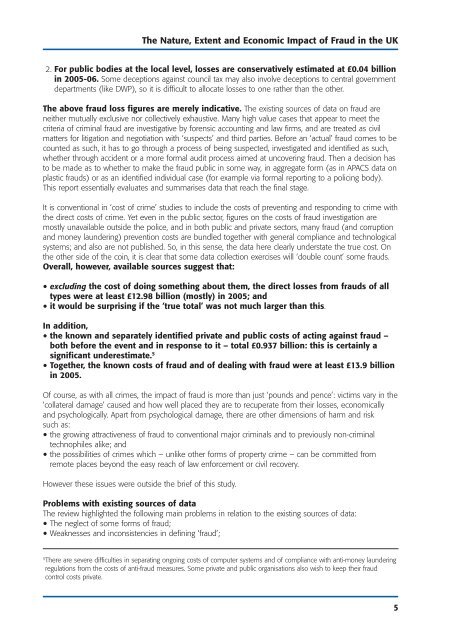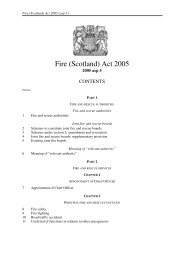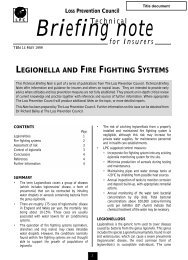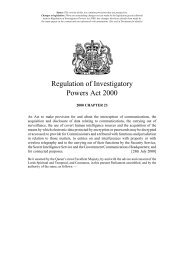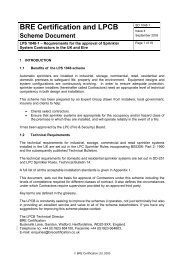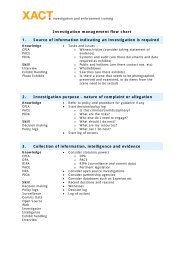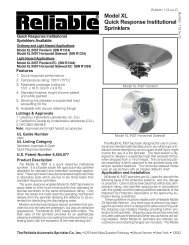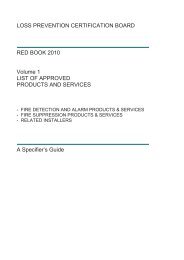The Nature, Extent and Economic Impact of ... - Cardiff University
The Nature, Extent and Economic Impact of ... - Cardiff University
The Nature, Extent and Economic Impact of ... - Cardiff University
Create successful ePaper yourself
Turn your PDF publications into a flip-book with our unique Google optimized e-Paper software.
<strong>The</strong> <strong>Nature</strong>, <strong>Extent</strong> <strong>and</strong> <strong>Economic</strong> <strong>Impact</strong> <strong>of</strong> Fraud in the UK<br />
2. For public bodies at the local level, losses are conservatively estimated at £0.04 billion<br />
in 2005-06. Some deceptions against council tax may also involve deceptions to central government<br />
departments (like DWP), so it is difficult to allocate losses to one rather than the other.<br />
<strong>The</strong> above fraud loss figures are merely indicative. <strong>The</strong> existing sources <strong>of</strong> data on fraud are<br />
neither mutually exclusive nor collectively exhaustive. Many high value cases that appear to meet the<br />
criteria <strong>of</strong> criminal fraud are investigative by forensic accounting <strong>and</strong> law firms, <strong>and</strong> are treated as civil<br />
matters for litigation <strong>and</strong> negotiation with ‘suspects’ <strong>and</strong> third parties. Before an ‘actual’ fraud comes to be<br />
counted as such, it has to go through a process <strong>of</strong> being suspected, investigated <strong>and</strong> identified as such,<br />
whether through accident or a more formal audit process aimed at uncovering fraud. <strong>The</strong>n a decision has<br />
to be made as to whether to make the fraud public in some way, in aggregate form (as in APACS data on<br />
plastic frauds) or as an identified individual case (for example via formal reporting to a policing body).<br />
This report essentially evaluates <strong>and</strong> summarises data that reach the final stage.<br />
It is conventional in ‘cost <strong>of</strong> crime’ studies to include the costs <strong>of</strong> preventing <strong>and</strong> responding to crime with<br />
the direct costs <strong>of</strong> crime. Yet even in the public sector, figures on the costs <strong>of</strong> fraud investigation are<br />
mostly unavailable outside the police, <strong>and</strong> in both public <strong>and</strong> private sectors, many fraud (<strong>and</strong> corruption<br />
<strong>and</strong> money laundering) prevention costs are bundled together with general compliance <strong>and</strong> technological<br />
systems; <strong>and</strong> also are not published. So, in this sense, the data here clearly understate the true cost. On<br />
the other side <strong>of</strong> the coin, it is clear that some data collection exercises will ‘double count’ some frauds.<br />
Overall, however, available sources suggest that:<br />
5 excluding the cost <strong>of</strong> doing something about them, the direct losses from frauds <strong>of</strong> all<br />
types were at least £12.98 billion (mostly) in 2005; <strong>and</strong><br />
5 it would be surprising if the ‘true total’ was not much larger than this.<br />
In addition,<br />
5 the known <strong>and</strong> separately identified private <strong>and</strong> public costs <strong>of</strong> acting against fraud –<br />
both before the event <strong>and</strong> in response to it – total £0.937 billion: this is certainly a<br />
significant underestimate. 5<br />
5 Together, the known costs <strong>of</strong> fraud <strong>and</strong> <strong>of</strong> dealing with fraud were at least £13.9 billion<br />
in 2005.<br />
Of course, as with all crimes, the impact <strong>of</strong> fraud is more than just ‘pounds <strong>and</strong> pence’: victims vary in the<br />
‘collateral damage’ caused <strong>and</strong> how well placed they are to recuperate from their losses, economically<br />
<strong>and</strong> psychologically. Apart from psychological damage, there are other dimensions <strong>of</strong> harm <strong>and</strong> risk<br />
such as:<br />
5 the growing attractiveness <strong>of</strong> fraud to conventional major criminals <strong>and</strong> to previously non-criminal<br />
technophiles alike; <strong>and</strong><br />
5 the possibilities <strong>of</strong> crimes which – unlike other forms <strong>of</strong> property crime – can be committed from<br />
remote places beyond the easy reach <strong>of</strong> law enforcement or civil recovery.<br />
However these issues were outside the brief <strong>of</strong> this study.<br />
Problems with existing sources <strong>of</strong> data<br />
<strong>The</strong> review highlighted the following main problems in relation to the existing sources <strong>of</strong> data:<br />
5 <strong>The</strong> neglect <strong>of</strong> some forms <strong>of</strong> fraud;<br />
5 Weaknesses <strong>and</strong> inconsistencies in defining ‘fraud’;<br />
5<br />
<strong>The</strong>re are severe difficulties in separating ongoing costs <strong>of</strong> computer systems <strong>and</strong> <strong>of</strong> compliance with anti-money laundering<br />
regulations from the costs <strong>of</strong> anti-fraud measures. Some private <strong>and</strong> public organisations also wish to keep their fraud<br />
control costs private.<br />
5


